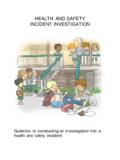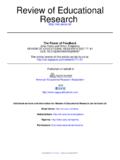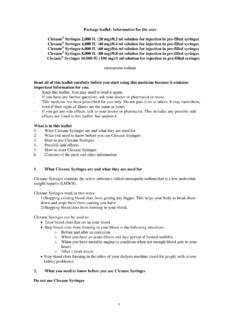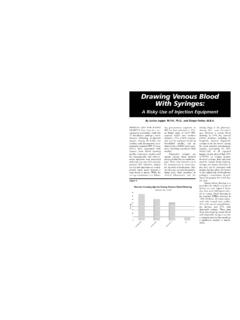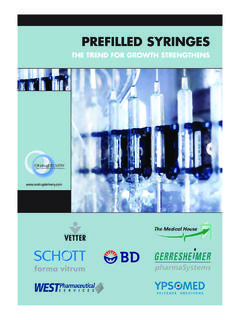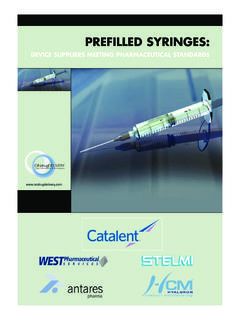Transcription of Health and Safety Fact Sheet - Safe Handling and …
1 Organisational Health Reviewed: January 2012. V3 Department of Education, Training and Employment Uncontrolled when printed SAFE Handling & DISPOSAL OF NEEDLES AND syringes Developed in consultation with Workplace Health and Safety Queensland, Needles and syringes Program- Queensland Health and Organisational Health Unit August 2007 Needle-stick injuries can cause considerable anxiety because of the fear of contracting blood-borne diseases such as HIV, hepatitis B and hepatitis C as well as other diseases such as tetanus. The risk of acquiring a disease from a needle-stick injury in a community setting is very low, however where needles/ syringes are found within school premises, it is important that they are disposed of promptly and safely to ensure staff, students and others are not harmed.
2 It is also important to know that unsafe disposal of needles and syringes is illegal. The Environmental Protection (Waste Management) Regulation 2000 requires that needles and syringes be disposed of in a rigid-walled, puncture-resistant, sealed container. What are needle stick injuries and sharps? Needle-stick injuries are wounds caused by needles that accidentally puncture the skin. Injection of blood-borne viruses is the major hazard of needle stick injuries, especially the viruses that cause AIDS (the HIV virus), hepatitis B and hepatitis C. The term sharps means objects or devices with sharp points, protuberances or cutting edges that are capable of cutting or piercing the skin.
3 How do we prevent needle stick injuries? Schools need to adopt practices that minimise the risk of students, staff or others coming into contact with sharps; Conduct regular inspection of the school grounds to ensure the early detection and disposal of discarded sharps Do not place your hands into areas or objects where you cannot see as sharps may be concealed there overgrown garden beds, rubbish bins. Use tongs or rubbish grabbers to pick up or move rubbish If students are required to pick up rubbish, provide them with suitable equipment Do not manually compress rubbish bags in case they contain needles/ syringes . What if someone finds a sharp ?
4 Students should never handle needles/ syringes Before staff handle sharps - move away any people (especially children) who are nearby Ensure there is space to move and to clearly observe the sharps and your hands Do not handle more than one item at a time. If there are multiple sharps, carefully separate them using a stick or implement do not try to flick them or pick them up with a grabber/implement Latest advice is that the best and safest way to pick up a syringe is to use your hands and immediately wash them afterwards. If the person is uncomfortable using their hands, thin disposable gloves that do not interfere with dexterity can be used.
5 The use of grabbers or other implements to pick up syringes increases the risk of injury through uncontrolled fl icking of the syringe. How do you dispose of sharps appropriately? See guidelines on page 3. The aim is to transfer the needle/syringe into an appropriate container safely to minimise the risk of needle-stick injury. Recognising a Sharps Container A sharps container is a receptacle intended for the collection and disposal of sharps. It is: rigid-walled, puncture-proof and sealable. Do not use glass jars or bottles, plastic drink containers or aluminium drink cans. These can break or may be recycled, potentially leading to injuries to other people such as waste collectors.
6 To minimise the risk of the sharp puncturing the container it is best to use a sharps container that complies with AS/NZS 4261:1994 -Reusable containers for the collection of sharp items used in human and animal medical application . Look for the following features: yellow in colour labelled as sharps or infectious waste carries the biohazard and AS/NZS symbols A designated sharps container is very easy to obtain and should be made available at every school. Contact the Clean Needle Help Line or First Aid suppliers. How do schools dispose of the sharps container? Schools should dispose of containers that contain needles/ syringes via a Queensland Health recommended facility or a facility recommended by your local council.
7 Do not dispose of sharps containers in the general waste. Do not throw needles/ syringes down drains because they may then be washed out to other areas Do not throw needles/ syringes down toilets Di sposing of sharps in these ways is unlawful. Organisational Health Reviewed: January 2012. V3 Department of Education, Training and Employment Uncontrolled when printed WHAT SHOULD SCHOOLS DO? Establish school-based procedures for dealing with needles and syringes found in school grounds based on the information in this fact Sheet . Ensure that your school s procedure regarding rubbish collection by staff, students and others follows the information in this fact Sheet o provide suitable equipment when picking up rubbish, such as a rubbish grabber tool.
8 This is to eliminate the risk of accidental hand to needle/syringe contact as sharps may be concealed under rubbish or vegetation. The rubbish grabber tool is not to be used to pick up sharps. o Staff only should handle syringes ; if there are multiple needles/ syringes , carefully separate them using a stick or extended implement do not try to pick them up with a grabber or flick them. syringes should be picked up using the hands. Disseminate the school-based procedures to all in the school community and train nominated people such as the Schools Officer (grounds and facilities) in the safe Handling and disposal of needles/ syringes . School can obtain a pack of 20 clean syringes from their local Needle Syringe Program and practice picking up and separating sharps.
9 This will help identify the method that works best and reduce anxiety with touching sharps. Educate students regarding how to identify needles/ syringes and sharps containers and what action they should take if they find these items for example; 1. do not touch the syringe, 2. one student acts as a spotter and stands near the needle/syringe to warn other students and 3. another student immediately reports it to a staff member Inform other school and community groups that use your facilities about your procedures Ensure you have sharps disposal kits at suitable locations around the school grounds, not just in the administration building. The kit should include a sharps container, disposable gloves and guidelines (next page).
10 The Schools Officer, Cleaning Staff and other Staff likely to find needles/ syringes should have their own sharps containers. If a needle/syringe is found at your school : o inform all staff, particularly Schools Officers and Cleaners. o keep a record of where and when you found the needle/syringe o ensure procedures are followed including proper disposal o discuss with staff to determine success or improvements to procedures. Hepatitis B Vaccination Vaccination for both Hepatitis A & B is an entitlement for both Schools Officers and Cleaners through industrial agreements. Vaccination costs and doctor s consultation costs are to be funded by the staff member s school. As a further precaution, schools should recommend and fund hepatitis B vaccinations for other individuals who are at high risk of coming into contact with needles or syringes .




